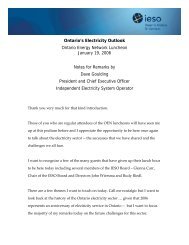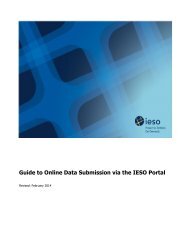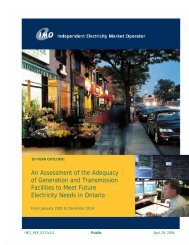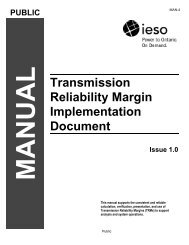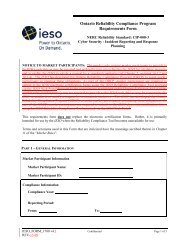Participant Technical Reference Manual - IESO
Participant Technical Reference Manual - IESO
Participant Technical Reference Manual - IESO
You also want an ePaper? Increase the reach of your titles
YUMPU automatically turns print PDFs into web optimized ePapers that Google loves.
<strong>Participant</strong> <strong>Technical</strong> <strong>Reference</strong> <strong>Manual</strong><br />
2. <strong>Participant</strong> Workstation, Network & Security<br />
2.2.3 Shared Network<br />
80 The Frame Relay network will be maintained through AT&T with <strong>IESO</strong> having<br />
responsibility for connectivity up to the Frame Relay Access Device (FRAD) or Router<br />
located on the market participant site. Static routing will be used across the interfaces<br />
between <strong>IESO</strong> and the market participant’s network. Reserved internal TCP/IP<br />
addresses may not be accepted due to possible conflicting addressing schemes on the<br />
network. An incremental cost sharing agreement must be agreed to with the <strong>IESO</strong> and<br />
the proportionate cost will be borne by the market participant.<br />
81 The market participant must provide the <strong>IESO</strong> with a registered TCP/IP Ethernet<br />
address for the Ethernet port that connects to the market participant’s internal network.<br />
82 RFC 1918 IP addressing will be accepted under certain conditions. Please contact the<br />
<strong>IESO</strong> prior to your installation.<br />
83 To arrange for a Frame Relay connection, contact the <strong>IESO</strong> (see www.<strong>IESO</strong>.ca).<br />
Connecting to the Supplied Ethernet Port<br />
84 A network connection will need to be established between the Ethernet Port on the<br />
FRAD and the market participant’s Internal Network.<br />
85 If distance between the Ethernet Port on the FRAD and the market participant’s<br />
Internal Network is an issue, then a recommended solution will be to deploy an<br />
Ethernet Repeater or “Ethernet Extender.” Ethernet Repeaters can effectively increase<br />
the distance of typical 10BASE-T Ethernet connections from around 182 meters (600<br />
feet) to over 7,300 meters (24,000 feet) using existing ordinary copper telephone wires.<br />
86 The IEEE 802.3 10BASE-T standard requires that 10BASE-T transceivers be able to<br />
transmit over a 100-meter (328 feet) link-using 24AWG unshielded twisted pair wire.<br />
Due to cable delay, the maximum link length is nearly always limited to about 200<br />
meters (656 feet), regardless of the cable type.<br />
87 As a general rule, links up to 150 meters (492 feet) long are achievable for unshielded<br />
and shielded twisted pair cable, with a maximum 200 meters (656 feet) due to cable<br />
delay. For each connector or patch panel in the link, subtract 12 meters (39.4 feet) from<br />
the 150-meter limit. This will allow for links of up to 126 meters (413.4 feet) using<br />
standard 24 AWG UTP wire and two patch panels within the link. Higher quality low<br />
attenuation cables may be required when using links greater than 126 meters.<br />
Traffic Aggregation<br />
88 The <strong>IESO</strong> will preserve the predictable response time of the Real Time network for<br />
market participants who chose to use the Frame Relay Network to submit bids, offers,<br />
and access market settlements and metering information over the Frame Backbone.<br />
89 Separate Permanent Virtual Circuits (PVC‟s) will be established with an appropriate<br />
Committed Information Rate (CIR) for each specific type of function. For example:<br />
Browser based HTTP traffic will be allocated its own Frame Relay PVC. The CIR<br />
value will be adjusted to accommodate the individual bandwidth requirements of each<br />
market participant. The incremental cost of this will be charged to the market<br />
participant.<br />
Issue 21.1 – March 15, 2010 - estimated Public 35




